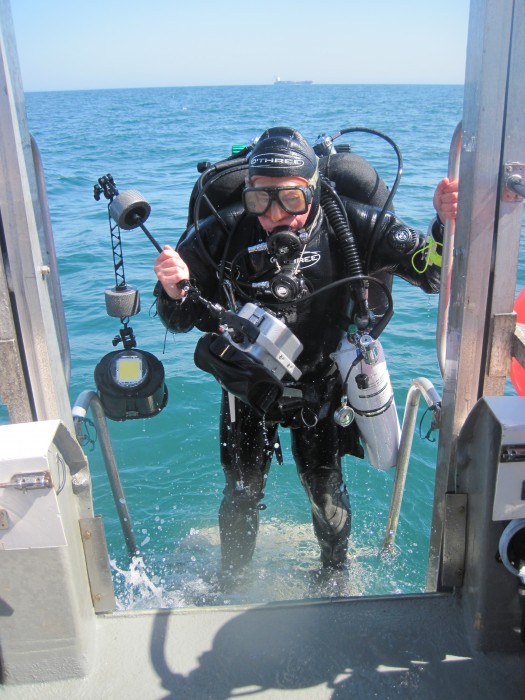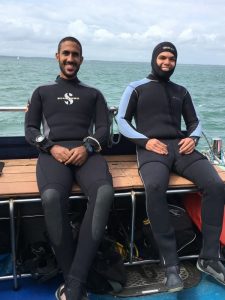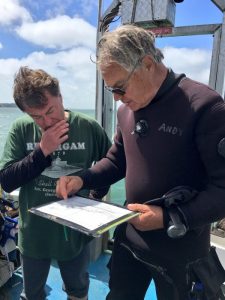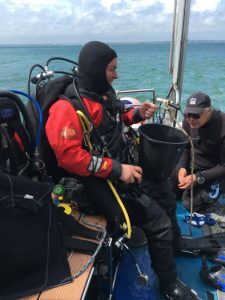
Diver being winched onto the boat after completing photogrammetry survey
The Maritime Archaeology Trust’s first proper fieldwork diving week took place in June. We were joined by researchers from the ForSEADiscovery project who specialise in analysing wood for maritime archaeological research.
Setting off from Lymington in the New Forest aboard the Wight Spirit we headed off towards the Isle of Wight. The weather was delightfully sunny and we were hoping for great visibility below the surface!
The first of our chosen sites was the SS South Western. She was sunk by a torpedo south of the Isle of Wight on 16th March 1917, with only 6 survivors out of a crew of 32. Many of the crew members had links to Southampton and consequently the SS South Western becomes a prominent part of the local history. The ship is part of our current Forgotten Wrecks of WWI project which is looking at ships that were lost during WWI, of 1914 to 1918, on the south coast of England. More on the project can be found here .
The aims and objectives for this site was to identify some key features on the ship. This included a detail recording of the cargo and boilers, and also locating the ship’s gun. The dive team managed to achieve a good amount of data for photogrammetry . This data will be compiled into a detailed 3D model for us to study in the comfort our dry (but very hot!) office. For an example of what a photogrammetry model looks like, please see the model of the HMD John Mitchell here.

Brandon and Garry looking at data from the wreck sites
The second wrecksite we wanted to look at this week was the SS Hazelwoood. The ship hit a mine on the 19th October 1917, with the loss of all 32 crew members. The location of the Hazelwood is still to be positively identified. However, our dive boat skipper and historian, Dave Wendes, believes that the wreck identified as the Saxmundham is in fact the SS Hazelwood. The wreck site is located at a depth of 32 meters. Previous dives on the site done in 2015 were plagued by poor visibility and as such we weren’t previously able to determine the identity of the wreck. This time the conditions were slightly better and we were able to conduct a photogrammetry survey. The photos taken of the site will be compiled into a 3D model which will hopefully help us determine the identity of the wreck once and for all.
The final site we looked at during this week was the submerged Mesolithic landscape at Bouldnor Cliff. The site dates back about 8000 years and has in-situ archaeological remains which are connected with the submerged landscape. The Mesolithic peat deposits lie at a depth of 12 meters, while two additional peat layers above broadly date to the Neolithic and Bronze Age. The aims and objectives of this survey was to check the erosion rate against the previously placed datum points across the site. We also took several sediment samples for palaeo-environmental analysis. Previous samples have concluded that e.g. wheat arrived in Britain 2000 years before we have evidence of humans farming it. Hopefully these new samples will add further knowledge into the nature of the landscape during the Mesolithic.
During the diving week we also had the pleasure of the company from a reporter, Rikke, who is doing coverage for BBC 3. Stay tuned for more updates during the summer!

Rikke querying Nigel and Garry about the finds

 Another day on Bouldnor Cliff reveals another exciting discovery. Garry Momber took part in the day’s first dive, and began to clear away some of the layer of mud covering the site. Underneath this mud he found a series of planks lying parallel to each other. Further dives will include more work on this potential platform, so the archaeologists can try to interpret the feature and its purpose. Yesterday, a diver found and recovered a small piece of flat, pointed timber that may turn out to be the end of a plank. Garry also recovered a small piece of wood, demonstrating the excellent preservation on this site. It is still possible to find organic material that is over 8,000 years old!
Another day on Bouldnor Cliff reveals another exciting discovery. Garry Momber took part in the day’s first dive, and began to clear away some of the layer of mud covering the site. Underneath this mud he found a series of planks lying parallel to each other. Further dives will include more work on this potential platform, so the archaeologists can try to interpret the feature and its purpose. Yesterday, a diver found and recovered a small piece of flat, pointed timber that may turn out to be the end of a plank. Garry also recovered a small piece of wood, demonstrating the excellent preservation on this site. It is still possible to find organic material that is over 8,000 years old! Miguel, Ziad, and Mohamed are still hard at work on the photogrammetric work. Miguel has been acting as underwater photographer, taking pictures of Garry at work and using a 6m x 2m grid to take photos to create a photogrammetric model of the site and some of the exposed timbers. Ziad and Mohamed are doing similar work, both with and without photogrammetric targets. The divers are working hard to ensure they don’t damage any of the exposed timbers as they do their work, and are being careful where they use targets. In places where the timber is fragile, it may be better to work without them. Eventually, the hundreds of photos taken will be combined together. They will be used to create a 3D model of the Mesolithic site, which can be manipulated and interpreted, and used for further study.
Miguel, Ziad, and Mohamed are still hard at work on the photogrammetric work. Miguel has been acting as underwater photographer, taking pictures of Garry at work and using a 6m x 2m grid to take photos to create a photogrammetric model of the site and some of the exposed timbers. Ziad and Mohamed are doing similar work, both with and without photogrammetric targets. The divers are working hard to ensure they don’t damage any of the exposed timbers as they do their work, and are being careful where they use targets. In places where the timber is fragile, it may be better to work without them. Eventually, the hundreds of photos taken will be combined together. They will be used to create a 3D model of the Mesolithic site, which can be manipulated and interpreted, and used for further study.
